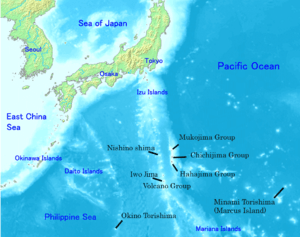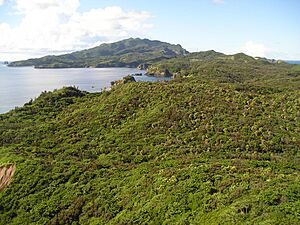Bonin white-eye facts for kids
Quick facts for kids Bonin white-eye |
|
|---|---|
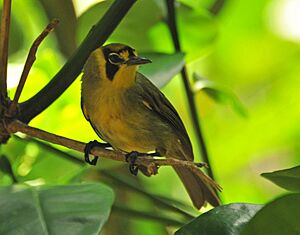 |
|
| Conservation status | |
| Scientific classification | |
| Genus: |
Apalopteron
|
| Species: |
familiare
|
The Bonin white-eye (Apalopteron familiare) is a small songbird. It lives only on the Bonin Islands (also called Ogasawara Islands) in Japan. This bird is the only species in its group, Apalopteron. For a long time, scientists weren't sure which bird family it belonged to. It was once thought to be a bulbul, a babbler, or even a honeyeater. Since 1995, we know it's a type of white-eye. It is closely related to the golden white-eye from the Marianas Islands.
The Bonin white-eye has mostly yellow and green feathers. It has a clear black patch around its eye, shaped like a triangle. A broken white ring also surrounds its eye. This bird used to live on all the main Bonin Islands. Now, it is only found on Hahajima Island. On Hahajima, it lives in almost all types of areas. This includes both natural forests and places changed by humans. However, it mostly builds its nests in native forests.
Fruit is a big part of its diet, especially mulberries. It also eats insects, flowers, seeds, spiders, and even small reptiles. The Bonin white-eye looks for food both in trees and on the ground. It spends more time on the ground than other white-eyes. Pairs of Bonin white-eyes stay together for a long time. They remain a pair throughout the year. They build a cup-shaped nest. Usually, they lay two eggs. Both parents take turns sitting on the eggs. They also both help raise the young birds.
When humans first came to the Bonin Islands, many native birds disappeared. The Bonin white-eye was also affected by these changes. One type of Bonin white-eye is now gone forever. The species is no longer found on many of the Bonin Islands. This bird is very important for the islands' nature. It helps spread seeds for native plants. It has managed to survive despite new challenges. These challenges include competition from warbling white-eyes. It also faces dangers from introduced rats and cats. Loss of its natural home is another threat. The Bonin white-eye is currently listed as "Near Threatened". This means it could become endangered soon.
Contents
About the Bonin White-eye
What Does It Look Like?
The Bonin white-eye is about 12 to 14 centimeters (5 to 5.5 inches) long. It weighs around 15 grams (0.5 ounces). The birds from the northern islands have a yellow head. They have a clear black eye-patch shaped like a triangle. A thin black line connects this patch to their black forehead. A thin black line also breaks the white ring around their eye. Their throat and upper chest are yellow. Their back and wings are olive-green with some grey. The main flight feathers have a brown tint.
Their tail is olive-brown. Their belly is pale yellow, with grey on the sides. Their eyes are brown. Their beak and legs are dark grey. Male and female birds look alike. Young birds also look very similar to adults. The birds from Hahajima Island are much like the northern ones. But their upper parts have a more yellowish-green color. They also have a slightly bigger beak and legs.
This bird usually flies slowly and straight. It only flies fast when chasing other birds. It often glides and hops instead of flying. It usually climbs trees by hopping up branches. Flying directly from the ground to the treetop is rare. Its legs are long, and its toes and claws are strong. This helps it move around on the ground. When on the ground, it hops like a thrush bird.
Where Does It Live?
As its name suggests, the Bonin white-eye lives only on the Bonin Islands. These islands are south of Japan. This bird once lived on all the main island groups. This included Mukojima, Chichijima, and Hahajima. Today, it only lives on Hahajima Island and two small islands nearby. It has disappeared from the other islands.
Scientists once debated if it naturally lived on Chichijima Island. It was later confirmed that it did. A bird from Chichijima was even the first specimen studied. All records of this bird on Chichijima are from the main island itself.
On Hahajima, the bird lives in almost every type of area. This includes untouched native forests. It also lives in forests that have been changed by humans. During the non-breeding season, it uses many different habitats. But when it's time to nest, it mostly stays in native forests. These forests have large trees, bamboo, and big shrubs. It is much rarer on windy mountain ridges. There, the plants are short and bushy. Local fishermen say the birds move to smaller islands in autumn and winter. However, these movements have not been fully confirmed.
How Does It Behave?
Sounds It Makes
For a long time, people thought the Bonin white-eye didn't sing much. Early reports said captive birds didn't sing. A 1985 report said it sang, but not often. It also said the bird didn't use its calls to defend its territory. Later research found that it does sing regularly. But it sings mostly very early in the morning, just before sunrise. It sings rarely during the rest of the day. Its song is likely used to defend its territory. About 90% of male birds with a mate sing. Some single males also sing. This morning song helps scientists count the birds. The song is musical. It sounds like a bunting or a Siberian blue robin. It can sound like chew-i, chit-chit-pee, chot-chot-pee, ch-ee or tu-ti-ti, ti-titu-tuoo.
The bird also makes other sounds. It often makes a fe-ee sound to keep in touch. It uses ch-ee or chit as alarm calls. It makes a scolding kyok call when people get too close to its nest. The male bird also makes a ze-ze-ze call when feeding its mate.
What It Eats
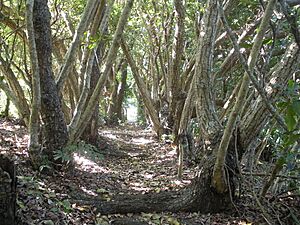
The Bonin white-eye eats many different things. Its diet includes fruits, flowers, and insects. This bird can find food in many places. It feeds both in trees and on the ground. Scientists think it developed these habits because there aren't many other bird species on the Bonin Islands. The types of food it eats can change with the seasons. It eats less on the ground during the breeding season.
Fruits, seeds, flowers, and nectar make up about half of its diet. It has been seen eating from 15 different plant species. Native mulberries (Morus boninensis) are a favorite food. It also eats many other fruits and flowers. These include both native and introduced plants. Native plants it eats include Rhaphiolepis and Leucaena. Introduced plants include bananas, papaya, and Lantana. The Bonin white-eye does drink some nectar. But we don't know how important nectar is to its diet. Observations showed it ate from flowers much less often than the warbling white-eye.
Besides plants, it also eats insects and other small creatures. Insects found in their stomachs include beetles, lacewings, true bugs, and ants. They have also been seen eating caterpillars, crickets, and flies. Sometimes, they even eat spiders and small reptiles.
How It Breeds
We don't know a lot about how the Bonin white-eye breeds. The main breeding season is from March to June, with most activity in May. It is believed that pairs stay together for a long time. They remain close throughout the year. Birds resting together usually do so in pairs. They typically build their nest in a tree fork. This is usually in a Shima tree, but other trees can be used. Nests are usually 1 to 12 meters (3 to 39 feet) off the ground. The average height is 6 meters (20 feet). One nest was even found inside a tree hole.
Both parents help build the nest. It is a deep, cup-shaped nest. It is mostly made from Pandanus plant fibers. Vines, grasses, pine needles, and roots are also woven in. The outside is lined with dead leaves. Finer materials are used to line the inside of the nest.
The eggs are 19.5–20.5 mm (0.77–0.81 in) long and 15–15.8 mm (0.59–0.62 in) wide. They are greenish-blue with brown spots. Usually, they lay about two eggs. This is a small number for a Japanese bird. Both parents sit on the eggs for just under two weeks. They feed the chicks for a month after they leave the nest.
Life in the Wild
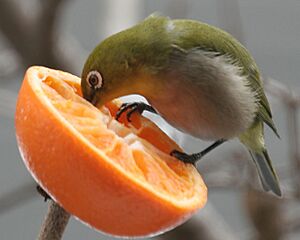
When warbling white-eyes were brought to the islands, people worried. They thought these new birds would harm the Bonin white-eye. But studies show this hasn't happened. This might be because the two species are different in how they look and act. The Bonin white-eye does change where it feeds when the warbling white-eye is around. It feeds lower in the trees. But its population, food choices, and chick size have not been affected. Young Bonin white-eyes join groups of warbling white-eyes and brown-eared bulbuls in the non-breeding season. Brown-eared bulbuls sometimes eat Bonin white-eye eggs.
Warbling white-eyes might have taught the Bonin white-eye new things. They may have shown them new foods in the human-changed Bonin Islands. This learning ability was shown with an experiment. Scientists put out tinned peaches, a new food, at feeding stations. At first, Bonin white-eyes avoided the peaches. But when they could watch warbling white-eyes eating the peaches, they started eating them too. Where no warbling white-eyes were present, the Bonin white-eyes did not try the new food.
The Bonin white-eye is very important for spreading seeds on the islands. This helps keep the forests healthy. The islands have few bird species. Many native birds, like the Bonin wood pigeon, have disappeared since humans arrived. In a study of birds on the islands, the Bonin white-eye was one of the top three seed dispersers. The other two were the brown-eared bulbul and the warbling white-eye.
Protecting the Bonin White-eye
The IUCN Red List says the Bonin white-eye is "Near Threatened". This means it is close to being endangered. The type of Bonin white-eye from Mukojima and Chichijima is thought to be extinct. Its current status on Chichijima is unclear. It was brought back there, but a 2003 study found none. We don't know why it disappeared from these two islands. It might be because its natural home was destroyed, especially the old forests.
The bird's situation on Hahajima seems safer. It was once thought to be vulnerable. Population estimates put the number of birds at about 4,000. But more accurate counts found over 15,000 birds. This study said the species was not in immediate danger of disappearing. Because of this study, its status was changed to "near threatened" in 2013.
Introduced cats hunt the Bonin white-eye. It is especially in danger because it often feeds on the ground. Its nests are also raided by introduced rats. It is also somewhat threatened by the loss of native forests. These forests are cleared for farming and tourism. However, the species is quite strong. It can handle some changes to its home. It can also deal with introduced predators and other birds. Its population is thought to be stable. It is still listed as near threatened. This is because extreme weather events could greatly harm the species.
The Bonin white-eye is protected by Japanese law. It is a National Endangered Species. The Bonin Islands are a National Wildlife Protection Area. This helps protect this bird. Efforts are being made to remove cats and rats from the islands. They are also removing invasive trees and planting native ones. Conservationists suggest regularly checking on the species. They also suggest moving birds to islands where they have disappeared. This would create more populations and reduce the risk of the species being wiped out by one event.
See also
- List of Special Places of Scenic Beauty, Special Historic Sites and Special Natural Monuments



